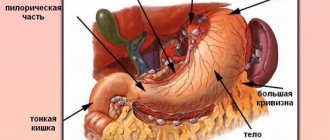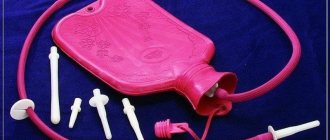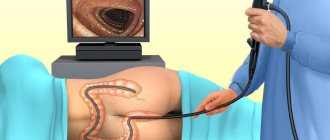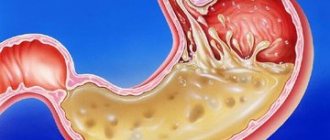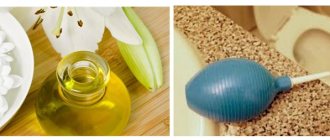Medicinal enema, placement algorithm
Medicinal enemas are divided into local-action enemas (micro-enemas) and general-action (drip) enemas. Medicinal enema (microenema). Target . Providing local effects for diseases of the rectum; general (resorptive) effect on the entire body. Indications . Diseases of the rectum. Contraindications . Acute inflammation of the anus; rectal tumor; gastrointestinal bleeding. Equipment . Medicinal solution as prescribed by a doctor; Janet syringe or rubber spray; sterile rectal tube 30 cm long or catheter; sterile petroleum jelly; sterile gauze wipes; water bath, clean jar; water thermometer; oilcloth, diaper.
Administration of a medicinal enema (microclyster):
1. The patient is warned about the upcoming procedure. Since you need to lie down after it, it is better to give the enema at night in the ward. 2. 30 - 40 minutes before administering a medicinal microenema, a cleansing enema is given. 3. The medicine in the indicated dose is poured into a clean jar and heated in a water bath to a temperature of +37...+38°C. 4. Take the medicine (50 - 200 ml), heated in a water bath, into a Janet syringe or rubber balloon. 5. Place an oilcloth under the patient, then a diaper and ask him to lie on his left side, pulling his legs, bent at the knees, towards his stomach. 6. A rectal tube (or catheter) is inserted into the rectum with a 20 cm rotational movement and connected to a Janet syringe (or balloon). 7. Slowly inject the medicine into the rectum in jerks. 8. Having finished the insertion, clamp the tube with your fingers, remove the syringe, draw a little air into it, connect the syringe to the tube again and, releasing the air from it, push it! remaining medication from the tube into the intestines. 9. Remove the syringe, clamp the tube, and carefully remove the tube from the rectum using rotational movements. 10. The patient is advised to take a comfortable position and not stand up.
Medicinal enema, technique of execution.
Notes . To avoid irritation of the rectal wall and the urge to defecate, the concentration of the drug should be hypertonic. The medicine should be administered in small volumes. The medicine must be heated. After use, the rectal tube is soaked in a 3% chloramine solution for 1 hour. If a catheter is used instead of a rectal tube, it should be labeled and used only for insertion into the rectum. The manipulation should be performed with rubber gloves.
Medicinal enemas are divided into local-action enemas (micro-enemas) and general-action (drip) enemas. Medicinal enema (microenema). Target . Providing local effects for diseases of the rectum; general (resorptive) effect on the entire body. Indications . Diseases of the rectum. Contraindications . Acute inflammation of the anus; rectal tumor; gastrointestinal bleeding. Equipment . Medicinal solution as prescribed by a doctor; Janet syringe or rubber spray; sterile rectal tube 30 cm long or catheter; sterile petroleum jelly; sterile gauze wipes; water bath, clean jar; water thermometer; oilcloth, diaper.
Administration of a medicinal enema (microclyster):
1. The patient is warned about the upcoming procedure. Since you need to lie down after it, it is better to give the enema at night in the ward. 2. 30 - 40 minutes before administering a medicinal microenema, a cleansing enema is given. 3. The medicine in the indicated dose is poured into a clean jar and heated in a water bath to a temperature of +37...+38°C. 4. Take the medicine (50 - 200 ml), heated in a water bath, into a Janet syringe or rubber balloon. 5. Place an oilcloth under the patient, then a diaper and ask him to lie on his left side, pulling his legs, bent at the knees, towards his stomach. 6. A rectal tube (or catheter) is inserted into the rectum with a 20 cm rotational movement and connected to a Janet syringe (or balloon). 7. Slowly inject the medicine into the rectum in jerks. 8. Having finished the insertion, clamp the tube with your fingers, remove the syringe, draw a little air into it, connect the syringe to the tube again and, releasing the air from it, push it! remaining medication from the tube into the intestines. 9. Remove the syringe, clamp the tube, and carefully remove the tube from the rectum using rotational movements. 10. The patient is advised to take a comfortable position and not stand up.
Medicinal enema, technique of execution.
Notes . To avoid irritation of the rectal wall and the urge to defecate, the concentration of the drug should be hypertonic. The medicine should be administered in small volumes. The medicine must be heated. After use, the rectal tube is soaked in a 3% chloramine solution for 1 hour. If a catheter is used instead of a rectal tube, it should be labeled and used only for insertion into the rectum. The manipulation should be performed with rubber gloves.
Features of performing an enema
An enema has a beneficial effect on the body and individual organs. When administered, including medication, absorption of the drug by the intestinal walls begins. If we talk about medicinal, it means more of a local effect. Of course, the body also benefits, only indirectly. The purpose of treatment is to influence the area of the body or organ that requires treatment.
A rubber bulb is used for staging. A less common option: a Janet syringe with a special catheter.
Indications for the procedure
Enema treatment is used for a wide range of diseases. It is advisable to consult a doctor before use. Moreover, when not just water or a decoction of herbs is administered, but a medicine. Below is a list of conditions for which colonic cleansing is used:
- Lack of results from taking laxatives.
- Incessant constipation.
- Infections in the rectal area.
- During illnesses when the use of sedatives and sleeping pills is required.
- Inability to administer the substance by alternative means.
- Inflamed rectum, sigmoid, small intestine.
- Inflammatory process of the prostate gland.
- Disturbed menstrual cycle.
- Cystitis.
In addition to the above, enemas are used before operations, intestinal examinations and childbirth.
A medicinal enema is administered for general purposes in the following cases:
- Undesirability of taking the medication and inability to take it orally.
- Liver dysfunction when nutrients and beneficial substances are not absorbed.
- The need to administer sleeping pills.
The composition of the solutions is varied. This includes medicinal herbs: chamomile, marshmallow, oak bark, valerian. Additionally, antibacterial drugs in the form of solutions, painkillers and others are used.
As mentioned above, a microenema differs from a regular cleansing one. The procedure is characterized by a small volume of administered drugs - from 50 to 200 ml. It produces a cleansing and local effect.
Enemas, how to use them?
- What types of enemas are there?
- What is a “cleansing enema”?
What is needed to perform an enema? - Contraindications
- How to give an enema?
- Hypertensive enema
Enema
(from the Greek word “klisma” - washing) is the procedure for introducing any liquids into the large intestine using various devices. Enemas have been used for therapeutic purposes for a very long time. Ancient Indian manuscripts describe rinsing enemas, and there are references to such treatment in Egyptian sources. Hippocrates developed a method of cleansing enemas from harmful juices through the use of gastric lavage, laxatives and cleansing enemas. Enemas were especially widely used in treatment in the 16th-18th centuries, when patients were given up to a dozen enemas in a row. The accumulated and generalized experience of using cleansing enemas suggests that a cleansing enema is not a harmless procedure. This procedure is a significant intervention in the functioning of the colon and the entire body. Unjustified, uncontrolled use of such enemas can lead to serious illnesses.
“Cleansing the body” with the help of enemas is now widely promoted in many systems of alternative medicine. You should know that the main ideologists of such treatment are fanatically enthusiastic people, often without sufficient knowledge of the fundamental areas of medicine. They try to crudely adapt existing scientific medical knowledge to their theory, often significantly distorting it. As a rule, to receive competent recommendations, you need to consult a specialist doctor who deals with this particular problem.
The large intestine performs two main functions: the absorption of nutrients and the formation of feces with its subsequent excretion. Digestion in this part of the intestine is carried out with the participation of the microflora of the colon and the active absorption of nutrients from the intestinal lumen. The microflora of the colon promotes the absorption of carbohydrates and proteins, thanks to which the body receives up to 10% of its daily energy needs. Every day, 1000 - 1500 ml of water enters the cecum from the small intestine along with intestinal contents. No more than 100-150 ml of water is excreted with feces per day, that is, 90% of the liquid is absorbed. Inhibition of the microbial flora when using cleansing enemas and broad-spectrum antibiotics leads to disruption of the colon and a deficiency of necessary substances.
The functioning of the colon is a very complex process. Roughly interfering with the mechanisms of its regulation at a young age, most likely you will encounter serious health problems later.
What types of enemas are there?
In general practice, the most commonly used are cleansing and therapeutic (medicinal) enemas.
What is a “cleansing enema”?
CLEANSING ENEMA
- this is the introduction of 1.5 liters of liquid into the large intestine for the purpose of emptying the colon of feces and gases in preparation for examination of the rectum before examination by a proctologist, before x-ray examination of the intestines, kidneys, before operations, childbirth, abortion, before the administration of medications enemas
What is needed to perform an enema?
An Esmarch mug is mainly used to administer an enema. It can be purchased at any pharmacy.
Esmarch's mug is a reservoir (glass, enamel or rubber) with a capacity of 1.5-2 liters. At the bottom of the mug there is a nipple onto which a thick-walled rubber tube is placed. For a rubber tank, the tube is its direct continuation. The tube is about 1.5 m long and 1 cm in diameter. The tube ends with a removable tip (glass, plastic) 8-10 cm long. The tip must be intact, with smooth edges. It is preferable to use plastic tips, since a glass tip with a chipped edge can seriously injure the intestine. After use, the tip is washed well with soap under running warm water and boiled. Next to the tip on the tube there is a tap that regulates the flow of fluid into the intestines. If there is no tap, it can be replaced with a clothespin, clamp, etc.
Use only water from proven sources (water that you can drink) for enemas. To perform enemas for children, use only boiled water. It is preferable to give an enema with water at a temperature of about 37-380 C. Colder water significantly increases the motor activity of the intestines and causes unpleasant pain. Using water with a temperature of more than 400 C for an enema is dangerous to health; severe burns of the colon are possible. When performing a cleansing enema, it is advisable to use a water thermometer.
Contraindications
Contraindication
to cleanse the intestines using enemas are:
abdominal pain of unknown nature,
acute inflammatory diseases in the anus,
bleeding from the rectum, hemorrhoids, rectal tumors in the decay stage, gastric and intestinal bleeding.
How to give an enema?
1 way:
Lie on the bed closer to the edge on your left side with your legs bent and pulled towards your stomach. Place an oilcloth (plastic film) under the buttocks, the free edge of which is lowered into a bucket in case you cannot hold water. 1-1.5 liters of water at room temperature are poured into Esmarch's mug, raised up to a height of 1-1.5 m and the tip lowered down to release a small amount of water and air from the tube. Fill the tube (drain a little liquid from the tube), then, without lowering the mug, close the tap on the rubber tube. Check to see if the tip is broken, lubricate it with Vaseline (soap, vegetable oil) and, spreading the buttocks, insert the tip into the anus with light rotational movements. The first 3-4 cm of the tip is inserted towards the navel, then another 5-8 cm parallel to the coccyx. If obstacles are encountered and the tube rests against the intestinal wall or hard feces, the tube is removed 1-2 cm and the tap is opened. Water is pressurized into the large intestine. Almost immediately there is a feeling of “fullness” in the intestines and an urge to stool. At these moments, reduce the flow rate of liquid from the mug by closing the tap on the tube or squeezing it. Soft circular stroking of the abdomen helps reduce discomfort.
If the tip is clogged with feces, it is removed, cleaned and reinserted. If the rectum is filled with feces, try to wash it away with a stream of water. Esmarch's mug is not completely emptied. Leaving a little water at the bottom so that air does not enter the intestines, close the valve regulating the flow of liquid and remove the tip.
A pre-prepared pad (fabric, repeatedly folded strip of toilet paper, etc.) is placed on the perineum, which is clamped between the legs.
Method 2 “according to Hegar”:
Get on all fours in the bathroom (knee-elbow position), leaning on one elbow, and insert the tip into the rectum with your other hand.
The tip must be inserted slowly and carefully, especially with hemorrhoids. Having inserted the tip, lower your head and shoulders lower, and begin to breathe deeply and infrequently with your stomach, “sucking in air through your mouth or nose.” If not all the water has entered, and you already feel pain in the intestines, turn off the tap on the hose and breathe deeply.
When the water in the mug runs out, remove the tip and place a pre-prepared pad on the anus.
It is advisable to hold the water for 10 minutes. To do this, lie on your back and breathe deeply. Soothe the pain and feeling of fullness in the abdomen with stroking. If possible, walk with the water injected close to the toilet or lie on your stomach. A plain water enema does not always lead to bowel movements. To enhance its effect, you can add to the water ½ teaspoon of powdered baby soap, 2-3 tablespoons of glycerin, 1-2 tablespoons of table salt, 1 glass of chamomile infusion or decoction, etc. When administering a cleansing enema, you need to ensure that so that no more than 1.5-2 liters of liquid are administered at a time. If you need to give 2 enemas in a row, you should maintain an interval of 45 minutes to 1 hour between them, making sure that the rinsing water from the first enema has completely drained.
What is a “medicinal enema”?
The peculiarity of medicinal enemas is that if they contain drugs that can be absorbed into the bloodstream, they do not enter the liver and are much less destroyed, acting more actively. If the administered drugs are not absorbed, they act only locally.
A cleansing enema is given 30-40 minutes before the medication and the medicine is administered after bowel movements. Medicinal enemas are mainly microenemas; the volume of their contents should not exceed 50-100 ml. The temperature of the medicinal substance should be at least 38 - 40 ° C, since at a lower temperature the urge to defecate occurs and the medicine does not have time to be absorbed.
The patient lies on his left side, legs bent at the knees and pulled up to the stomach. Spreading the buttocks with your left hand, insert a catheter lubricated with Vaseline oil 10 cm into the rectum with your right hand using rotational movements. Then connect the catheter with a syringe containing the medicinal substance, and slowly squeeze this solution into the catheter in small portions under low pressure. For this purpose, you can use a small syringe. Next, hold and compress the outer end of the catheter to prevent fluid from flowing back out of it. Carefully remove the syringe from the catheter, draw air into it, reinsert it into the catheter and blow through it to push out the remaining liquid. In order not to cause mechanical, thermal and chemical irritation of the intestines, it is necessary to introduce drugs into it in a relatively low concentration, diluted in a warm isotonic solution of sodium chloride or with an enveloping substance (50 g of starch decoction).
Hypertensive enema
Hypertonic enemas cause a good laxative effect, without sharp intestinal peristalsis. Typically, for hypertensive enemas, a 5-10% solution of sodium chloride, a 20-30% solution of magnesium sulfate or sodium sulfate is used. 100-200 ml of warm solution is injected into the rectum using a rubber balloon - a “pear”.
Contraindications are inflammatory and ulcerative processes in the lower part of the colon.
Oil enemas
Oil enemas are used for persistent constipation. For this, vegetable oils are used: sunflower, olive, hemp, vaseline. For one enema, take 50-100 ml of oil heated to 37-40°C. The oil is usually administered with a rubber balloon, through a syringe with a catheter, which is advanced 10 cm into the rectum. The oil spreads along the intestinal wall, envelops the feces, relaxes the intestinal muscles and promotes the excretion of feces. The patient should lie still for 10-15 minutes so that the oil does not leak out.
Starch enemas
Starch enemas are used to reduce peristalsis and as an enveloping emollient for acute colitis. To do this, 5 g of starch (potato, rice, corn, wheat) are diluted in 100 ml of cool water and, stirring, gradually add 100 ml of boiling water. Then the solution is cooled to 38-40°C and injected into the rectum.

